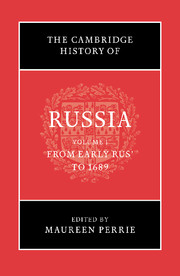78 results
Challenges During a Chlorine Gas Emergency Response
-
- Journal:
- Disaster Medicine and Public Health Preparedness / Volume 10 / Issue 4 / August 2016
- Published online by Cambridge University Press:
- 29 March 2016, pp. 553-556
-
- Article
- Export citation
Contributors
-
-
- Book:
- Behavioral Emergencies for the Emergency Physician
- Published online:
- 05 April 2013
- Print publication:
- 21 March 2013, pp viii-xii
-
- Chapter
- Export citation
Ivan the Terrible: A Military History. By Alexander Filjushkin. London: Frontline Books, 2008. xiv, 306 pp. Appendixes. Notes. Bibliography. Chronology. Index. Illustrations. Plates. Photographs. Maps. £25.00, hard bound.
-
- Journal:
- Slavic Review / Volume 68 / Issue 4 / Winter 2009
- Published online by Cambridge University Press:
- 27 January 2017, pp. 993-994
- Print publication:
- Winter 2009
-
- Article
- Export citation

The Cambridge History of Russia
-
- Published online:
- 28 March 2008
- Print publication:
- 14 September 2006
26 - Popular revolts
- from Part III - Russia Under the First Romanovs (1613–1689)
-
-
- Book:
- The Cambridge History of Russia
- Published online:
- 28 March 2008
- Print publication:
- 14 September 2006, pp 600-617
-
- Chapter
- Export citation
Index
-
- Book:
- The Cambridge History of Russia
- Published online:
- 28 March 2008
- Print publication:
- 14 September 2006, pp 722-777
-
- Chapter
- Export citation
1 - Introduction
-
-
- Book:
- The Cambridge History of Russia
- Published online:
- 28 March 2008
- Print publication:
- 14 September 2006, pp 1-18
-
- Chapter
- Export citation
Plate section"
-
- Book:
- The Cambridge History of Russia
- Published online:
- 28 March 2008
- Print publication:
- 14 September 2006, pp -
-
- Chapter
- Export citation
Frontmatter
-
- Book:
- The Cambridge History of Russia
- Published online:
- 28 March 2008
- Print publication:
- 14 September 2006, pp i-xxii
-
- Chapter
- Export citation
Part II - The Expansion, Consolidation and Crisis of Muscovy (1462–1613)
-
- Book:
- The Cambridge History of Russia
- Published online:
- 28 March 2008
- Print publication:
- 14 September 2006, pp -
-
- Chapter
- Export citation
Part I - Early Rus’ and the Rise of Muscovy (c. 900–1462)
-
- Book:
- The Cambridge History of Russia
- Published online:
- 28 March 2008
- Print publication:
- 14 September 2006, pp -
-
- Chapter
- Export citation
Plate section"
-
- Book:
- The Cambridge History of Russia
- Published online:
- 28 March 2008
- Print publication:
- 14 September 2006, pp -
-
- Chapter
- Export citation
Bibliography
-
- Book:
- The Cambridge History of Russia
- Published online:
- 28 March 2008
- Print publication:
- 14 September 2006, pp 663-721
-
- Chapter
- Export citation
Part III - Russia Under the First Romanovs (1613–1689)
-
- Book:
- The Cambridge History of Russia
- Published online:
- 28 March 2008
- Print publication:
- 14 September 2006, pp -
-
- Chapter
- Export citation
18 - The Time of Troubles (1603–1613)
- from Part II - The Expansion, Consolidation and Crisis of Muscovy (1462–1613)
-
-
- Book:
- The Cambridge History of Russia
- Published online:
- 28 March 2008
- Print publication:
- 14 September 2006, pp 409-432
-
- Chapter
- Export citation
Tsars and Cossacks: A Study in Iconography. By Serhii Plokhy. Harvard Papers in Ukrainian Studies. Cambridge, Mass.: Ukrainian Research Institute, Harvard University, 2002. Dist. Harvard University Press, x, 102 pp. Notes. Bibliography. Index. Illustrations. $18.95, paper.
-
- Journal:
- Slavic Review / Volume 63 / Issue 2 / Summer 2004
- Published online by Cambridge University Press:
- 27 January 2017, pp. 394-395
- Print publication:
- Summer 2004
-
- Article
- Export citation
Russia’s First Civil War: The Time of Troubles and the Founding of the Romanov Dynasty. By Chester S. L. Dunning. University Park: Pennsylvania State University Press, 2001. xiv, 657 pp. Notes. Bibliography. Index. Illustrations. Maps. $65.00, hard bound.
-
- Journal:
- Slavic Review / Volume 61 / Issue 1 / Spring 2002
- Published online by Cambridge University Press:
- 27 January 2017, pp. 155-156
- Print publication:
- Spring 2002
-
- Article
- Export citation
Velikorusskii pakhar' i osobennosti rossiiskogo istoricheskogo protsessa. By L. V. Milov. Moscow: ROSSPEN, 1998. 573 pp. Notes. Illustrations. Tables. Maps. Hard bound.
-
- Journal:
- Slavic Review / Volume 58 / Issue 4 / Winter 1999
- Published online by Cambridge University Press:
- 27 January 2017, pp. 912-913
- Print publication:
- Winter 1999
-
- Article
- Export citation
Prologue: Tsarevich Dimitry and Boris Godunov
-
- Book:
- Pretenders and Popular Monarchism in Early Modern Russia
- Published online:
- 03 December 2009
- Print publication:
- 21 September 1995, pp 7-32
-
- Chapter
- Export citation
Part 2 - Rebels in the name of Tsar Dimitry
-
- Book:
- Pretenders and Popular Monarchism in Early Modern Russia
- Published online:
- 03 December 2009
- Print publication:
- 21 September 1995, pp 107-108
-
- Chapter
- Export citation



